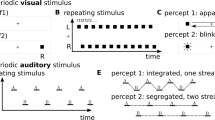Abstract
Stochastic dynamics and critical slowing down were studied experimentally and numerically near the onset of dynamical bistability in visual perception under the influence of noise. Exploring the Necker cube as the essential example of an ambiguous figure, and using its wire contrast as a control parameter, we measured dynamical hysteresis in two coexisting percepts as a function of both the velocity of the parameter change and the background luminance. The bifurcation analysis allowed us to estimate the level of cognitive noise inherent to brain neural cells activity, which induced intermittent switches between different perception states. The results of numerical simulations with a simple energy model are in good qualitative agreement with psychological experiments.







Similar content being viewed by others
References
Aks DJ, Sprott JC (2003) The role of depth and 1/f dynamics in perceiving reversible figures. Nonlinear Dyn Psychol Life Sci 7(2):161–180
Atteneave F (1971) Multistability in perception. Sci Am 225:63–71
Borisyuk R, Chik D, Kazanovich Y (2009) Visual perception of ambiguous figures: synchronization based neural models. Biol Cybern 100:491–504
Broggi G, Colombo A, Lugiato LA, Mandel P (1986) Influence of white noise on delayed bifurcations. Phys Rev A 33:3635–3636
Chialvo DR, Apkarian AV (1993) Modulated noisy biological dynamics: three examples. J Stat Phys 70(1/2):375–391
Deco G, Rolls ET, Romo R (2009) Stochastic dynamics as a principle of brain function. Prog Neurobiol 88:1–16
Figley CR, Sprenkle DH (1978) Delayed stress response syndrome: family therapy indications. J Marital Fam Ther 4:5360
Gigante G, Mattia M, Braun J, Del Giudice P (2009) Bistable perception modeled as competing stochastic integrations at two levels. PLoS Comput Biol 5:e1000430
Haken H (1983) Synergetics. An Introduction. Springer, Berlin
Hanson RF, Spratt EG (2000) Reactive attachment disorder: what we know about the disorder and implications for treatment. Child Maltreat 5:137–145
Hebb DO (1949) The organization of behavior. Wiley, New York
Huerta-Cuellar G, Pisarchik AN, Kir’yanov AV, Barmenkov YuO, del Valle Hernández J (2009) Prebifurcation noise amplification in a fiber laser. Phys Rev E 79:036204
Kalarickal GJ, Marshall JA (2000) Neural model of temporal and stochastic properties of binocular rivalry. Neurocomputing 32–33:843–853
Kanai R, Moradi F, Shimojo S, Verstraten FAJ (2005) Perceptual alternation induced by visual transients. Perception 34:803–822
Kapral R, Mandel P (1985) Bifurcation structure of the non-autonomous quadratic map. Phys Rev A 32:1076–1081
Köhler W, Wallach H (1944) Figural after-effects, an investigation of visual processes. Proc Am Philos Soc 88:269–357
Kramers HA (1940) Brownian motion in a field of force and the diffusion model of chemical reactions. Physica 7:284–360
Lago-Fernandez LF, Deco G (2002) A model of binocular rivalry based on competition in IT. Neurocomputing 44:503–507
Leopold DA, Wilke M, Maier A, Logothetis NK (2002) Stable perception of visually ambiguous patterns. Nat Neurosci 5:605609
Mandel P, Erneux T (1984) Laser Lorenz equations with a time-dependent parameter. Phys Rev Lett 53:1818–1820
Merk I, Schnakenberg J (2002) A stochastic model of multistable visual perception. Biol Cybern 86:111–116
Meyn SP, Tweedie RL (eds) (2008) Markov Chains and stochastic stability. Cambridge University Press, Cambridge
Moreno-Bote R, Rinzel J, Rubin N (2007) Noise-induced alternations in an attractor network model of perceptual bistability. J Neurophysiol 98:11251139
Moreno-Bote R, Knill DC, Pouget A (2011) Bayesian sampling in visual perception. PNAS. doi:10.1073/pnas.1101430108
Pisarchik AN, Feudel U (2014) Control of multistability. Physics Reports (in press). doi:10.1016/j.bbr.2011.03.031
Pisarchik AN, Chizhevsky VN, Corbalán R, Vilaseca R (1997) Experimental control of nonlinear dynamics by slow parametric modulation. Phys Rev E 55(3):2455–2461
Pisarchik AN (1998) Dynamical tracking of periodic orbits. Phys Lett A 242(3):152–162
Pisarchik AN, Pochepen ON, Pisarchyk LA (2012) Increasing blood glucose variability is a precursor of sepsis and mortality in burned patients. PLoS One 7(10):e46582
Rolls ET (2008) Emotion, higher order syntactic thoughts, and consciousness. In: Weiskrantz I, Davies MK (eds) Frontiers of consciousness. Oxford University Press, Oxford, pp 131–167
Rolls ET (2008) Memory, attention, and decision-making: a unifying computational neuroscience approach. Oxford University Press, Oxford
Schwartz J-L, Grimault N, Hupé J-M, Moore CJBCJ, Pressnitzer D (2012) Multistability in perception: sensory modalities, an overview. Phil Trans R Soc B 367:896–905
Shpiro A, Moreno-Bote R, Rubin N, Rinzel J (2009) Balance between noise and adaptation in competition models of perceptual bistability. J Comput Neurosci. doi:10.1007/s10827-008-0125-3
Simonotto E, Riani M, Seife C, Roberts M, Twitty J, Moss F (1997) Visual perception of stochastic resonance. Phys Rev Lett 78(6):1186–1189
Ta’edd LK, Ta’eed O, Wright JE (1988) Determinants involved in the perception of the necker cube: an application of catastrophe theory. Behav Sci 33(2):97–115
Tolhurst DJ, Movshon JA, Dean AF (1983) The statistical reliability of signals in single neurons in cat and monkey visual cortex. Vis Res 23:775–785
Tredicce JR, Lippi GL, Mandel P, Charasse B, Chevalier A, Picqué B (2004) Critical slowing down at a bifurcation. Am J Phys 72:799–809
World Medical Association (2000) Declaration of Helsinki: ethical principles for medical research involving human subjects. JAMA 284(23):3043–3045
Acknowledgments
We thank K. M. Prado-Tabares for her help in the data collection and all voluntaries for their participation in the experiments. A. N. P. acknowledges support from CONACYT (Mexico).
Author information
Authors and Affiliations
Corresponding author
Additional information
This work has been supported by the COECYTJAL-UdeG through project 05-2010-1-783.
Rights and permissions
About this article
Cite this article
Pisarchik, A.N., Jaimes-Reátegui, R., Magallón-García, C.D.A. et al. Critical slowing down and noise-induced intermittency in bistable perception: bifurcation analysis. Biol Cybern 108, 397–404 (2014). https://doi.org/10.1007/s00422-014-0607-5
Received:
Accepted:
Published:
Issue Date:
DOI: https://doi.org/10.1007/s00422-014-0607-5




